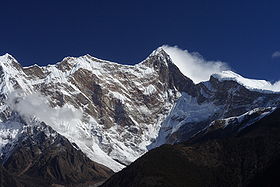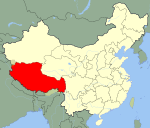- Namjagbarwa
-
Namjag Barwa 
Namcha Barwa from the west, from Zhibai observation platformElevation 7,782 m (25,531 ft)
Ranked 28thProminence 4,106 m (13,471 ft)
Ranked 19thListing Ultra Location Location in eastern Tibet Location China
Tibet Aut. Reg.
Nyingchi Prefecture
Mêdog County
north of McMahon LineRange Himalayas
Namcha Barwa HimalCoordinates 29°37′50″N 95°03′19″E / 29.63056°N 95.05528°ECoordinates: 29°37′50″N 95°03′19″E / 29.63056°N 95.05528°E Climbing First ascent 1992, China-Japan expedition Easiest route SSW ridge on rock, snow and ice Namcha Barwa (officially: Namjag Barwa; Tibetan in Wylie transliteration: gnam lcags 'bar ba; Chinese: 南迦巴瓦峰, Pinyin: Nánjiābāwǎ Fēng) is a mountain in the Tibetan Himalaya. The traditional definition of the Himalaya extending from the Indus River to the Brahmaputra would make it the eastern anchor of the entire mountain chain, and it is the highest peak of its own section as well Earth's easternmost peak over 7,600 metres.[1]
Contents
Location
Pamcha Barwa is in an isolated part of southeastern Tibet rarely visited by outsiders. It stands inside the Great Bend of the Yarlung Tsangpo River as the river enters its notable gorge across the Himalaya, emerging as the Dihang and becoming the Brahmaputra. Namcha Barwa's sister peak Gyala Peri 7,294 metres rises across the gorge 22 km to the NNW.
Notable features
Namcha rises 5,000 to 6,800 metres above the Yarlung Tsangpo.[2][3] After 7,795 metre Batura Sar in the Karakoram was climbed in 1976, Namcha Barwa became the highest unclimbed independent mountain in the world.[4], until it was finally climbed in 1992.
Frank Kingdon-Ward may have presaged the effects of global warming some 85 years ago when describing "a quaint prophecy among the Kongbo Tibetans that Namche Barwa will one day fall into the Tsangpo gorge and block the river, which will then turn aside and flow over the Doshong La [pass]. This is recorded in a book by some fabulous person whose image may be seen in the little gompa [monastery] at Payi, in Pome. " (126-7)
Climbing history
Namcha Barwa was located in 1912 by British surveyors but the area remained virtually unvisited until Chinese alpinists began attempting the peak in the 1980s. Although they scouted multiple routes, they did not reach the summit.[5] In 1990 a Japanese-Chinese expedition reconnoitered the peak.[6] Another joint expedition reached 7460m in 1991 but lost member Hiroshi Onishi in an avalanche.[7] The next year a third Japanese-Chinese expedition established six camps on the South Ridge over intermediate Nai Peng (7,043m) reaching the summit October 30.[8] U.K. Alpine Club's Himalayan Index[9] lists no further ascents.
Footnotes
- ^ Neate, Jill (1990). High Asia: An Illustrated History of the 7,000 Metre Peaks. Seattle: Mountaineers Books. pp. 1–4;14–15. ISBN 0-89886-238-8.
- ^ Namjagbarwa Mountaineering Map (1:50,000), Chinese Research Institute of Surveying and Mapping, China Mountaineering Association, 1990, ISBN 7-5031-0538-0.
- ^ High Asia digital elevation models
- ^ American Alpine Journal 1993, pp. 279-280.
- ^ Neate, 1990, op. cit..
- ^ "Namcha Barwa". American Alpine Journal (Boulder, Colorado: American Alpine Club) 33 (65): 285. 1991. http://c498469.r69.cf2.rackcdn.com/1991/285_china_tibet_aaj1991.pdf. Retrieved May 19, 2011.
- ^ Tsuneo Shigehiro. "Japan China joint expedition to Namcha Barwa 1992". http://www.jac.or.jp/english/kiroku/1992/namc92_e.htm. Retrieved May 19, 2011.
- ^ "Shigehiro, 1992, op. cit.". http://www.jac.or.jp/english/kiroku/1992/namc92_e.htm.
- ^ "Himalayan Index". London: Alpine Club. http://www.alpine-club.org.uk/hi/screen1.php. Retrieved May 18, 2011.
External links
- Chinese expedition in the 1980s
- U.S. Army Map Service (1955). Namcha Barwa, NH 46-12 (Map). 1:250,000. http://www.lib.utexas.edu/maps/ams/china/txu-oclc-10552568-nh46-12.jpg. Retrieved 2011-06-08.
Categories:- Mountains of Tibet
Wikimedia Foundation. 2010.


